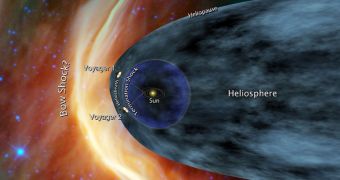According to a new set of calculations compiled by researchers at the American space agency, it would appear that the Voyager 1 spacecraft may exit the solar system, and enter interstellar space, a lot earlier than previously thought. In fact, this could happen at any time.
The new calculations are based on data provided by the NASA Voyager and Cassini spacecraft. The former is currently flying through the outer boundary of the solar system, while the other has been orbiting Saturn, studying the gas giant, its rings and its moon system since July 1, 2004.
In a paper published in this week's issue of the top scientific journal Nature, Voyager mission managers at the NASA Jet Propulsion Laboratory (JPL), in Pasadena, California, say that the spacecraft may cross the boundary into interstellar space at any point.
If this happens, then it would mean that the early calculations the scientists relied upon were wrong. Voyager was not “officially” scheduled to exist the solar system for another few years. However, no one is complaining that the transition is made earlier rather than later.
A low-energy charged particle instrument on Voyager 1 began sending weird data in December 2010, showing no readings of the outward speed of the charged particles streaming from the Sun. This could only mean one of two things.
The first scenario is that the winds suddenly shifted direction, by as much as 90 degrees, due to influences from the interstellar medium. The second scenario is that the spacecraft indeed reached the extent of the Sun's influence – the transition zone to outer space.
“There is one time we are going to cross that frontier, and this is the first sign it is upon us,” explains the principal investigator of Voyager's low-energy charge particles instrument, Tom Krimigis.
The expert is also the principal investigator of the magnetospheric imaging instrument on the Cassini orbiter. He holds an appointment as a professor at the Johns Hopkins University (JHU) Applied Physics Laboratory (APL), in Laurel, Maryland.
The new “calculations show we're getting close, but how close? That's what we don't know, but Voyager 1 speeds outward a billion miles every three years, so we may not have long to wait,” adds Voyager project scientist Ed Stone, from the the California Institute of Technology in Pasadena.
The boundary experts are hoping to cross soon is located at an estimated 11 billion miles (18 billion kilometers) from the solar surface, which is roughly the distance Voyager 1 is from the star anyway.

 14 DAY TRIAL //
14 DAY TRIAL //